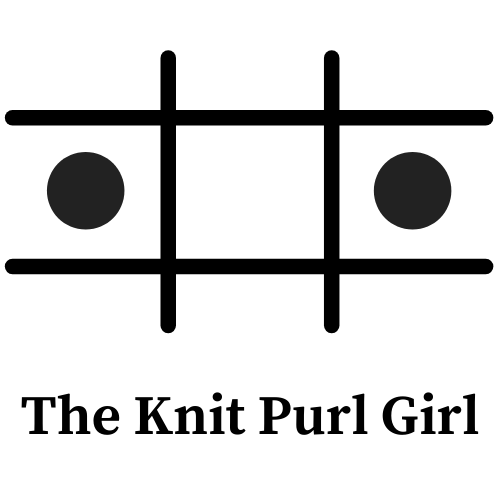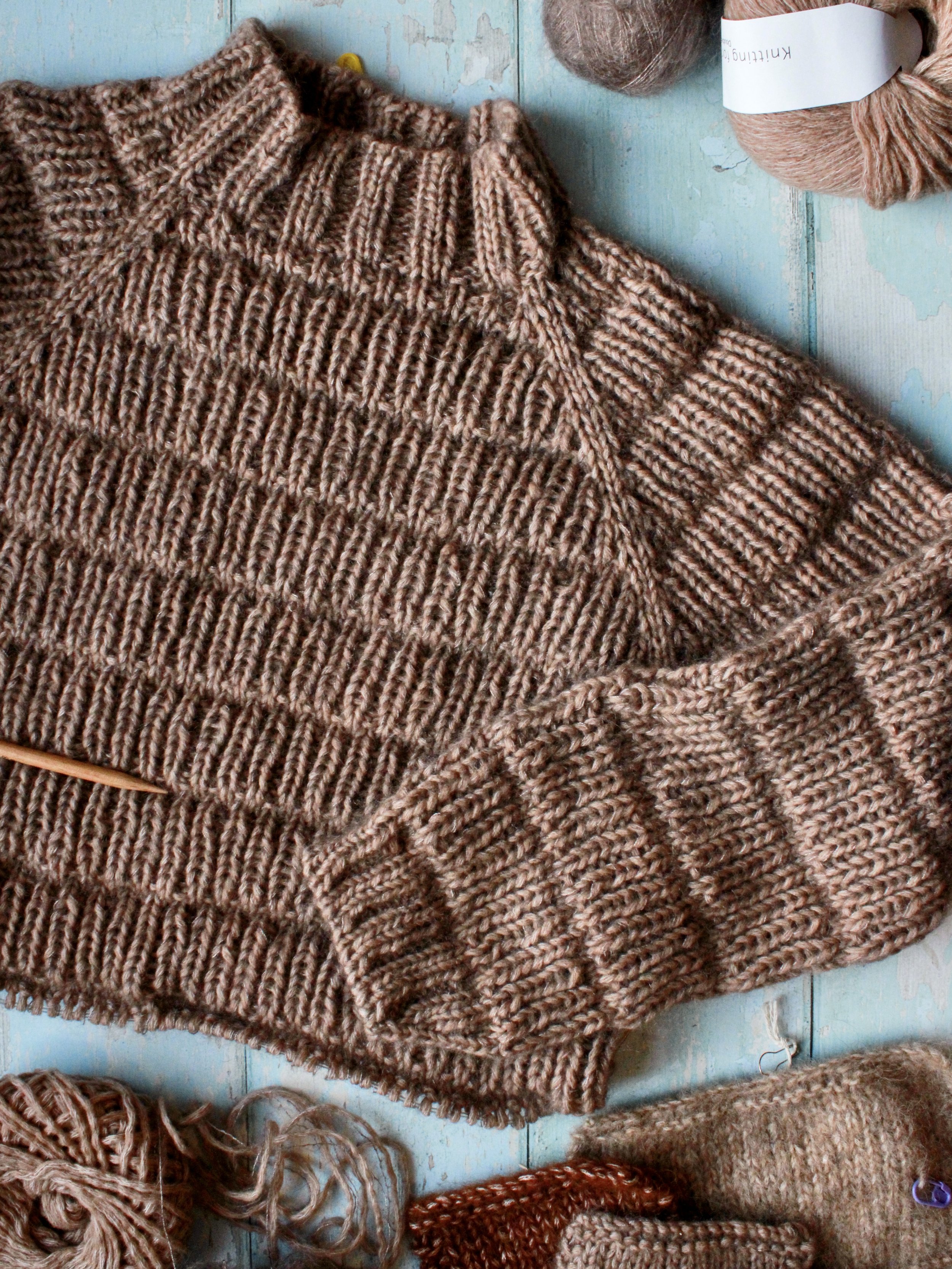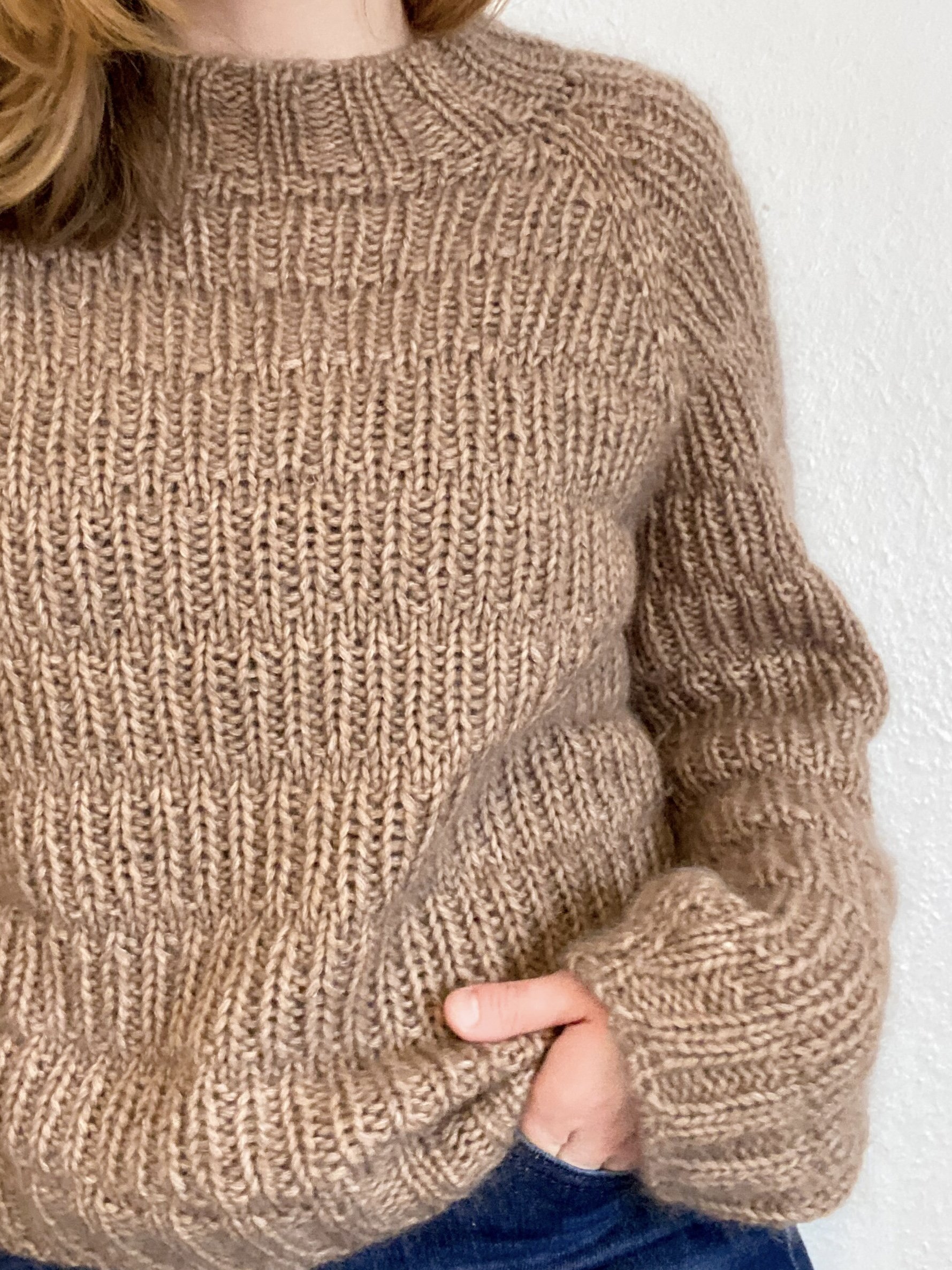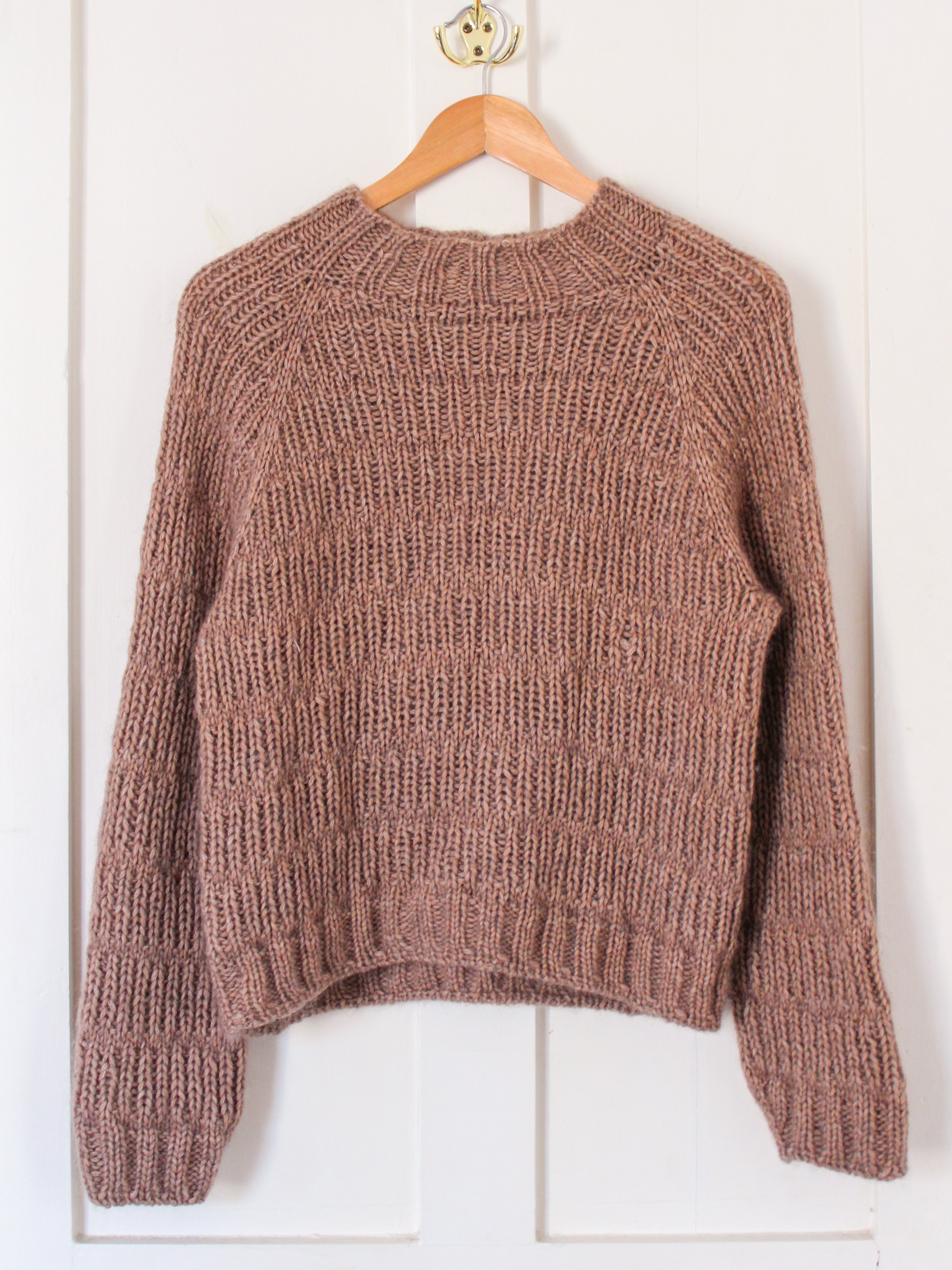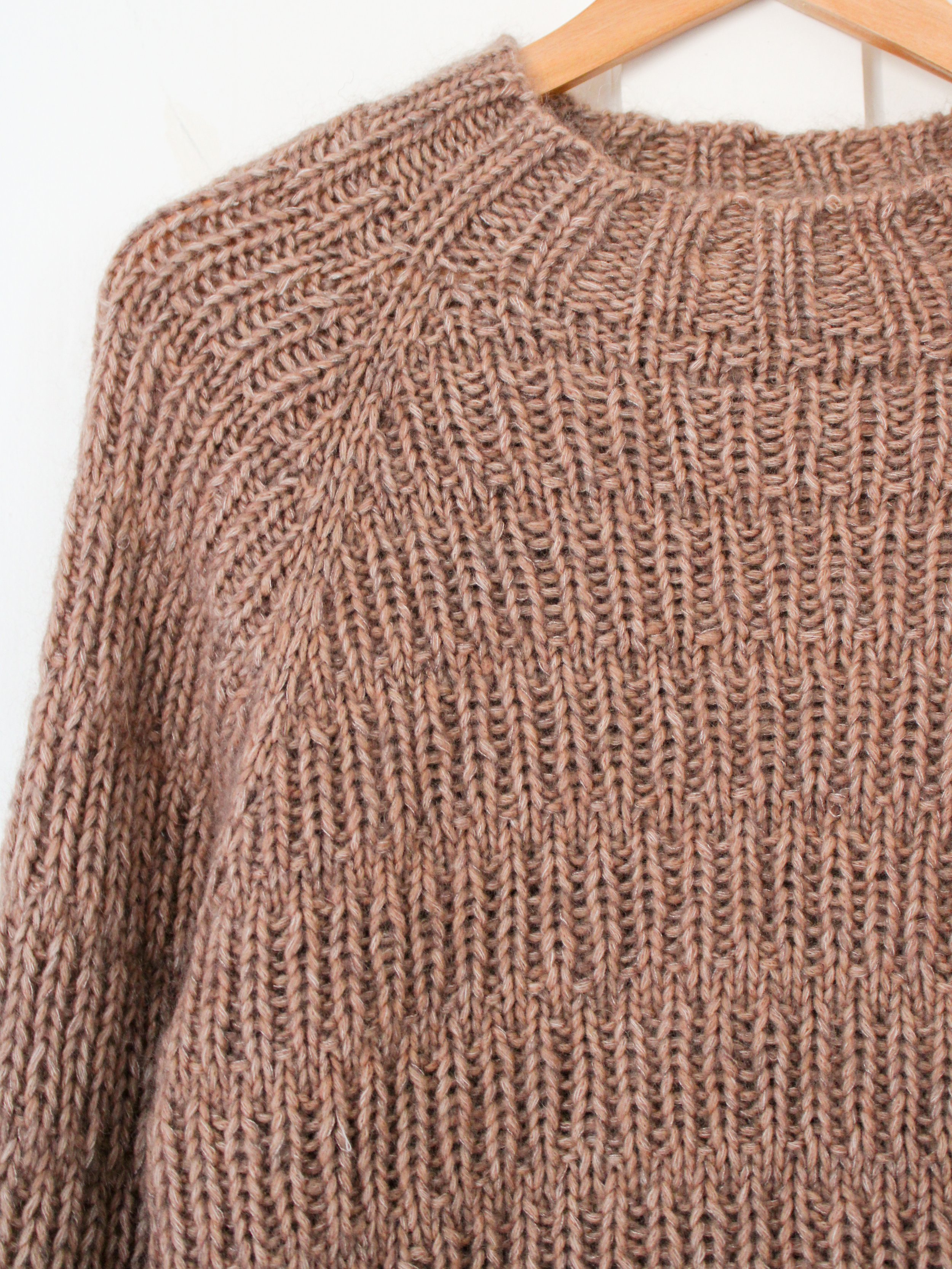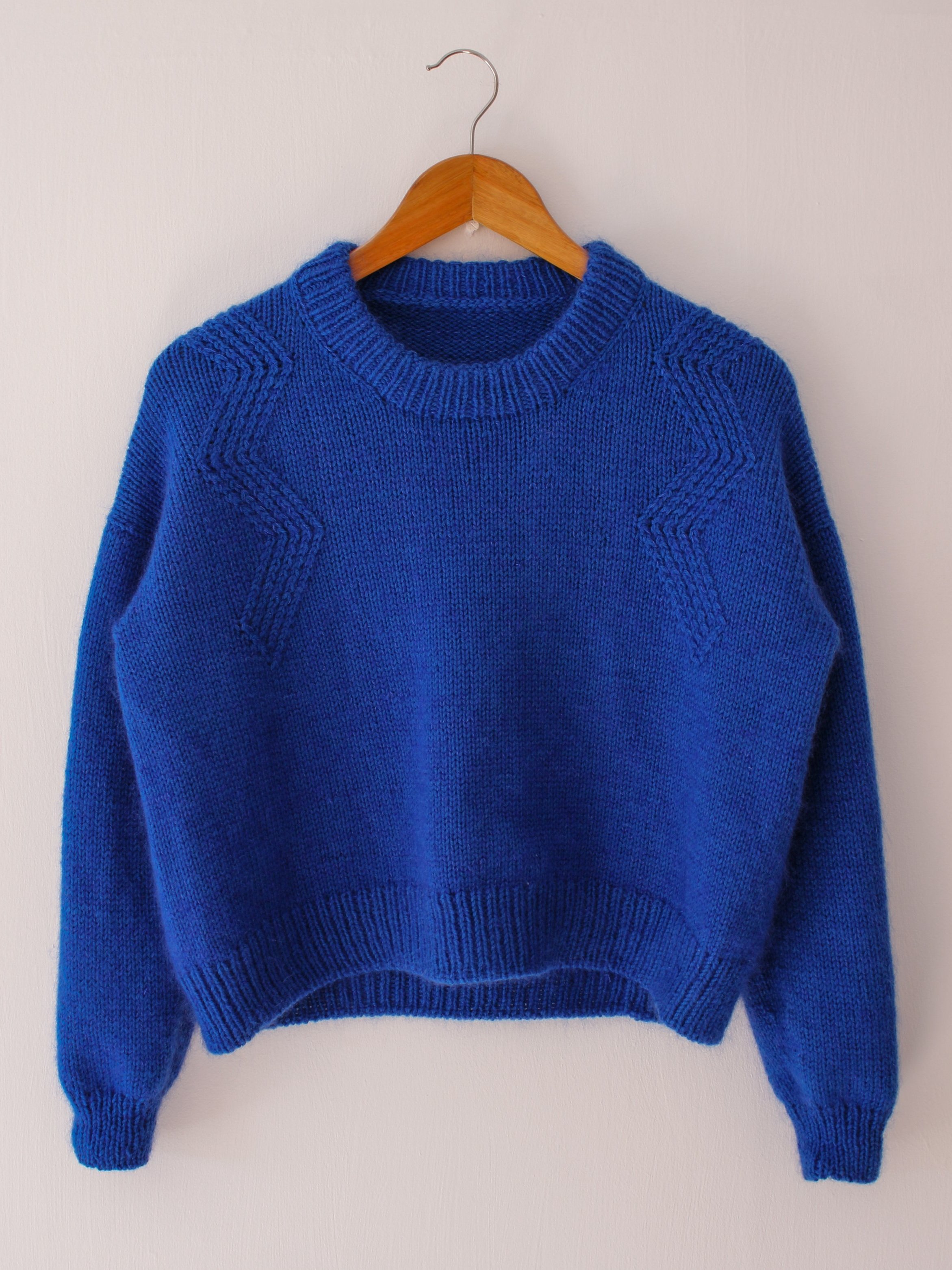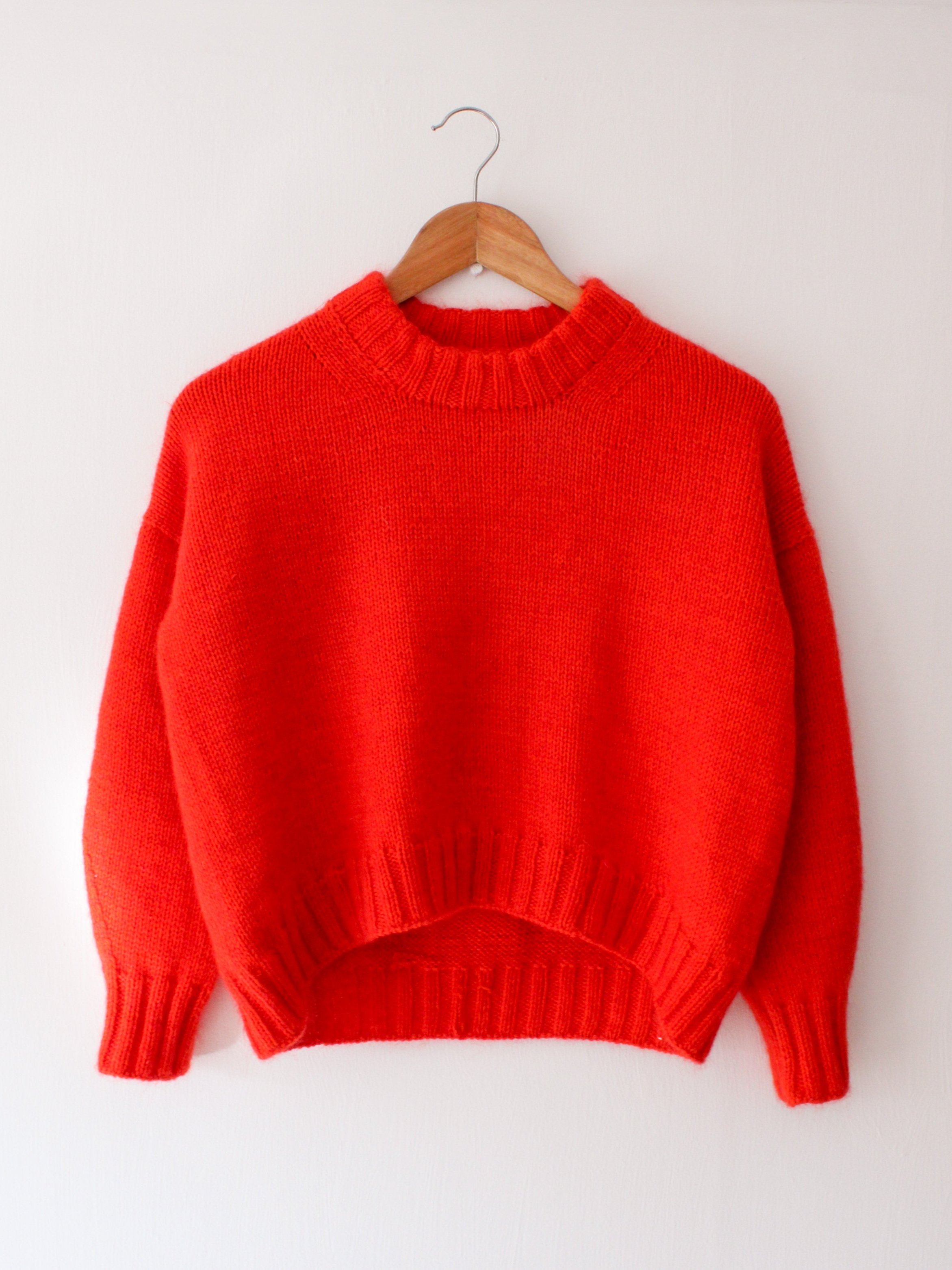Corteccia Sweater
The Corteccia Sweater is a celebration of texture. It is a simple and comfy sweater, perfect for chilly autumn days.
The Sweater itself is worked top-down and in the round using a combination of aran- and lace-weight yarns, or a single strand of a bulky-weight yarn, if you prefer to work with just one yarn at a time. It starts with some German short rows and raglan shaping, all of which is worked in an offset 1x1 rib stitch pattern. Once the yoke is finished, you will leave the sleeves to rest and work the body to your desired length. You will then pick up the stitches for the sleeves and work them with some gentle decreases to create a slight taper. I recommend that you finish the body and sleeves with tubular cast-offs, but you can use your preferred method. Finally, you pick up stitches to form the collar, which you can either work as a double-folded collar (as seen in the pink sample) or a funnel neck (as seen in the brown sample) in 2x2 rib, to match the sleeve cuffs and the final section of the body.
This is an intermediate level pattern. The techniques and stitches are both fairly simple in and of themselves, but you will need to be comfortable with maintaining stitch patterns whilst also working increases to be able to successfully make this pattern. Where I have been able to do so, I have written the stitch pattern out but, to keep the pattern as concise as possible.
Please note that this is a digital pdf and not a physical knitting pattern.
This pattern has been professionally tech edited and test knitted, but should you encounter any issues please email me at **the.knit.purl.girl2020@gmail.com**.
The Corteccia Sweater is a celebration of texture. It is a simple and comfy sweater, perfect for chilly autumn days.
The Sweater itself is worked top-down and in the round using a combination of aran- and lace-weight yarns, or a single strand of a bulky-weight yarn, if you prefer to work with just one yarn at a time. It starts with some German short rows and raglan shaping, all of which is worked in an offset 1x1 rib stitch pattern. Once the yoke is finished, you will leave the sleeves to rest and work the body to your desired length. You will then pick up the stitches for the sleeves and work them with some gentle decreases to create a slight taper. I recommend that you finish the body and sleeves with tubular cast-offs, but you can use your preferred method. Finally, you pick up stitches to form the collar, which you can either work as a double-folded collar (as seen in the pink sample) or a funnel neck (as seen in the brown sample) in 2x2 rib, to match the sleeve cuffs and the final section of the body.
This is an intermediate level pattern. The techniques and stitches are both fairly simple in and of themselves, but you will need to be comfortable with maintaining stitch patterns whilst also working increases to be able to successfully make this pattern. Where I have been able to do so, I have written the stitch pattern out but, to keep the pattern as concise as possible.
Please note that this is a digital pdf and not a physical knitting pattern.
This pattern has been professionally tech edited and test knitted, but should you encounter any issues please email me at **the.knit.purl.girl2020@gmail.com**.
The Corteccia Sweater is a celebration of texture. It is a simple and comfy sweater, perfect for chilly autumn days.
The Sweater itself is worked top-down and in the round using a combination of aran- and lace-weight yarns, or a single strand of a bulky-weight yarn, if you prefer to work with just one yarn at a time. It starts with some German short rows and raglan shaping, all of which is worked in an offset 1x1 rib stitch pattern. Once the yoke is finished, you will leave the sleeves to rest and work the body to your desired length. You will then pick up the stitches for the sleeves and work them with some gentle decreases to create a slight taper. I recommend that you finish the body and sleeves with tubular cast-offs, but you can use your preferred method. Finally, you pick up stitches to form the collar, which you can either work as a double-folded collar (as seen in the pink sample) or a funnel neck (as seen in the brown sample) in 2x2 rib, to match the sleeve cuffs and the final section of the body.
This is an intermediate level pattern. The techniques and stitches are both fairly simple in and of themselves, but you will need to be comfortable with maintaining stitch patterns whilst also working increases to be able to successfully make this pattern. Where I have been able to do so, I have written the stitch pattern out but, to keep the pattern as concise as possible.
Please note that this is a digital pdf and not a physical knitting pattern.
This pattern has been professionally tech edited and test knitted, but should you encounter any issues please email me at **the.knit.purl.girl2020@gmail.com**.
Materials & Fit
Sizing and ease: The Corteccia Sweater has about 7-15 cm [2.75-6 in] positive ease for sizes A-G, and 10-20 cm [4-7.75 in] positive ease for sizes H-J. The sample garments are both Size C, to fit a model with a 92 cm chest. If you would like a closer fitting or looser garment, size up or down accordingly. The sizes are as follows:
Size: A (B) C (D) E, (F) G (H) I (J)
Chest measurement (cm): 80-85 (85-90) 90-95 (95-100) 100-105 (105-110) 110-115 (115-125) 125-135 (135-145)
Chest measurement (in): 31.5-33.5 (33.5-35.5) 35.5-37.5 (37.5-39.3) 39.3-41.3 (41.3-43.3) 43.3-45.3 (45.3-49.2) 49.2-53.1 (53.1-57)
Actual circumference of garment (cm): 92.5 (98.5) 105 (108) 114 (117) 123 (135) 144 (154)
Actual circumference of garment (in): 36.5 (38.75) 41.25 (42.5) 45 (46) 48.5 (53.25) 56.75 (60.75)
Notions: 5 mm [US 8], 6 mm [US 10], and 7 mm circular needles or the size required to meet gauge. You may find a 40 cm [16 in] needle useful for the collar and sleeves, a 60 cm [24 in] needle for the yoke, and an 80 or 100 cm [32 or 40 in] needle for the body. You may also find some 6 mm [US 10], and 7 mm double-pointed knitting needles useful for the sleeves.
I am aware that 7 mm needles can be hard to find in the US. If you are unable to find this needle size, I would recommend trying a 6.5 mm [US 11] needle instead as I have relatively tight tension. If this is too tight, try an 8 mm [US 11] instead.
You will also need 8 stitch markers, one of which should be in a contrasting colour to indicate the beginning of the round, a darning needle, and some spare needles/scrap yarn/stitch holders where the stitches of the sleeves will rest. I would highly recommend having some clip-on markers to help you keep track of your rounds and some shirring elastic to tighten the collar.
Yarn: You will need approximately 5 (5) 6 (6) 6 (6) 7 (7) 8 (9) skeins of Kit Couture Blow (37% alpaca, 26% wool, 2% viscose, 35% polyamide; 50 g = 175 m/191 yards) held together with 4 (5) 5 (5) 5 (5) 6 (6) 7 (7) skeins of Drops Kid-Silk (75% mohair, 25% silk; 25 g = 210 m/230 yards). The pink sample was made in the shades Lyserød(/’Pink’) and Light Pink 03 respectively. The original brown sample was made with Knitting for Olive Double Soft Merino (100% merino wool; 50 g = 125 m/136 yards) held with Filcolana Tilia (70% mohair, 30% silk; 25 g = 210 m/230 yards) in the shades Soft Cognac and Truffle respectively. However, Double Soft Merino has since been discontinued and, as such, I sadly cannot recommend this yarn.
This works out to be 875 (875) 875 (1,050) 1,050 (1,050) 1,225 (1,225) 1,400 (1,575) m [955 (955) 955 (1,146) 1,146 (1,146) 1,337 (1,337) 1,528 (1,719) yds] of Kit Couture Blow held together with 840 (1,050) 1,050 (1,050) 1,050 (1,050) 1,260 (1,260) 1,470 (1,470) m [920 (1,150) 1,150 (1,150) 1,150 (1,150) 1,380 (1,380) 1,610 (1,610) yds] of Drops Kid-Silk.
Yarn alternatives: Any worsted-weight blown yarn held with a single strand of mohair will work well here. Drops Air held with 1 strand of mohair is another good option. Alternatively, you could use a bulky-weight yarn held single. Most mohair/lace-weight alpaca yarns will work well as the second strand for this project.
I have found that blown yarns made with 100% natural fibres tend to stretch or grow with wash and wear much more than natural-synthetic blends, which may affect the size you choose to make.
Where possible, buy more yarn than you need to avoid issues with dye lots.
Tension: 13 stitches x 21 rows in an offset variation of 1x1 rib stitch (detailed below) on 7 mm needles = 10 x 10 cm [4 x 4 in].
As 1x1 rib stitch is very stretchy and relaxes with blocking, it’s really important to wash and block your swatch and use this for the basis of your measurement before you cast on.
You can reinforce the collar of this sweater with shirring elastic and a sewing needle to counteract this potential for growth but if you are using a blown yarn, I would work on the assumption that the garment will grow with wash and wear, especially if your yarn is made of 100% natural fibres.
